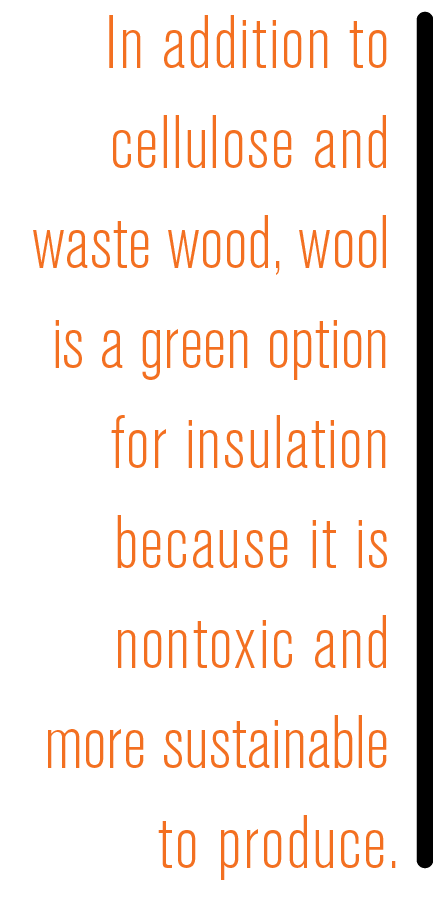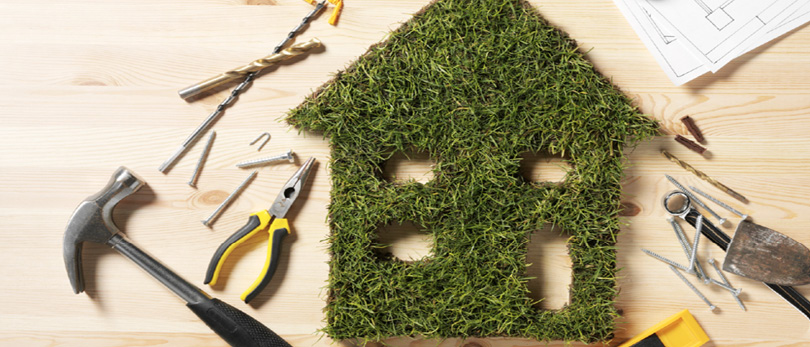Eco-friendly building materials are becoming more commonplace in new home construction
By Megan Kramer
Green products are not a new concept. Many people are opting for reusable grocery bags and water bottles over plastic, buying electric cars and starting their own composting bins in an effort to be kinder to the environment. But can you go green while building a new home—a process that has historically been costly and disruptive to the environment?

With the right building materials and knowledge, the answer is yes.
“Whether it’s young people or empty nesters, we have seen a significant uptick in people asking for eco-friendly materials,” says Mike Trolle, cofounder and principal at BPC Green Builders, Inc. “As the conversation about climate change becomes more prominent and more real to people, they are taking a thoughtful approach to building their homes.”
For Trolle, a thoughtful approach considers the sustainability of materials, their carbon footprint and chemical emissions, as well as overall airtightness of the home, which contributes to how much energy a home uses. “We want our homes to be part of the solution, not the problem,” he says.
Continue reading to learn more about green materials and products, so you can successfully recommend them to your clients who are looking to build an eco-friendly home.
It starts in the bones
Most homes are still built with conventional wood, but there are myriad alternatives available. Here are some examples:
Recycled steel is a greener choice than wood—and one GH Builders USA is taking advantage of, says VP of development Jason August. GH Builders USA works with a partner company that produces panels from recycled steel and polystyrene to build structures that are durable, well-insulated and absorb noise better than wood, he says.
Structural insulated panels (SIPs) are made with oriented strand boards, which is engineered wood similar to plywood, that sandwich a foam core. SIPs are more sustainable to produce than other building materials and are airtight and well-insulated.
Other green options for building a home’s structure include reclaimed, recycled or sustainable wood; rammed earth; straw bales; stone; and bamboo. All materials have their own benefits and drawbacks, so be sure to investigate before recommending them to a client.
Trolle notes that, no matter the material used to build the home, a big focus at BPC Green Builders is airtightness. Many older homes are not airtight and don’t have ventilation systems, which not only degrades air quality in the home, but causes temperature fluctuations that affect comfort. This also contributes to significant energy usage and waste, as well as a more costly energy bill, Trolle says.
Make the roof multitask
Another major component of a home is its roof, and there are various ways to go green here. Living roofs are a popular option, especially if a home doesn’t have much of a yard or greenery surrounding it. Living roofs, also known as green roofs, comprise a waterproofing membrane, a growing medium like soil and vegetation, all overlaid on a traditional roof. The result is a beautiful, biodiverse garden on top of your home. It may sound messy, but living roofs can increase water retention, limiting run-off that would otherwise go straight into storm sewers. They can also reduce noise and improve air quality because many plants are natural air filters.
If your clients are considering solar energy for their home, there are more options than ever before. Instead of installing large, not-great-looking solar panels onto a home’s roof, for example, clients may be able to request solar shingles. Solar shingles look and act like conventional roof shingles, so they are both durable and more aesthetically pleasing.
A greener way to insulate
Common types of insulation are spray foam and fiberglass, and both can have negative effects on your lungs. Spray foam insulation is also high in embodied carbon (the amount of carbon dioxide emission when producing materials), which can contribute to climate change. For this reason, Trolle says his company is limiting foam when possible and instead using cellulose insulation, which is made from recycled paper products.

Trolle also notes that there is an insulation board product manufactured in Europe made from waste wood that is being used for continuous insulation (insulation that covers thermal bridges, where heat is likely to escape). Currently, most products used for continuous insulation are made from foam, but Trolle anticipates waste wood products manufactured in the U.S. in the near future.
In addition to cellulose and waste wood, wool is a green option for insulation because it is nontoxic and more sustainable to produce.
Building with intention
Clients may have misgivings about straying from conventional materials or have questions about new materials before they commit. Being able to educate clients about green homes is a huge step to convincing them that the benefits are worth the cost and commitment, says August. And if you have a client who can’t afford eco-friendly materials but still wants to do their part, there’s good news: Intentional design goes a long way.
“You can achieve energy efficiency just from designing a home properly,” August notes. “You can use standard materials, so there won’t be a lot of extra cost.”
Sharing Solar Power
If installing solar panels or solar shingles onto a roof isn’t a viable option, homeowners are still in luck.
Jason August, VP of development at GH Builders USA, sees community solar farms being implemented more frequently in the future. These “farms” are groupings of solar panels that provide power to all the homes in a nearby community.
NAR has a GREEN Designation for agents who specialize in green homes. Find out more at green.realtor.
Photo: iStock.com/wragg








